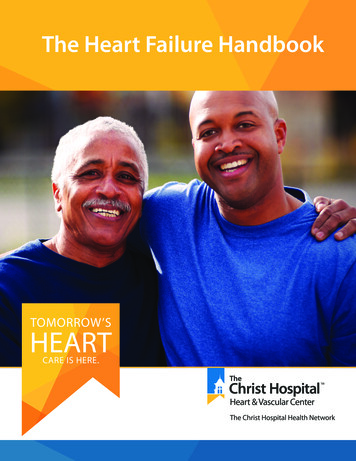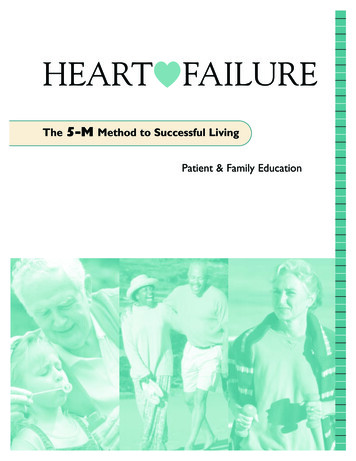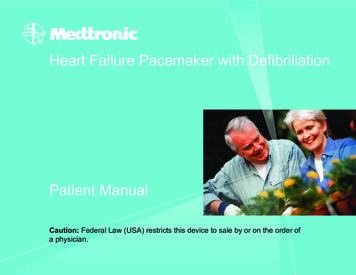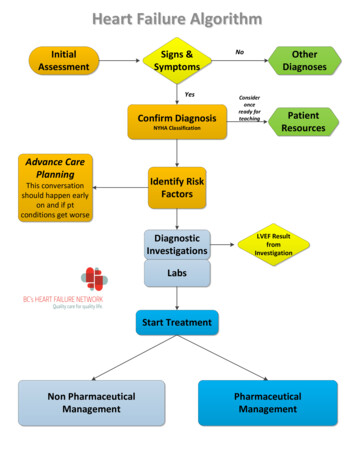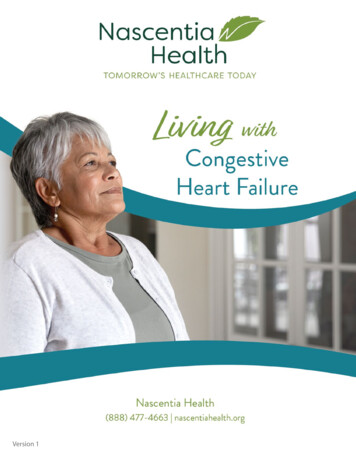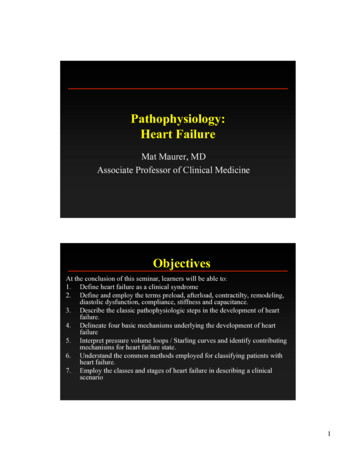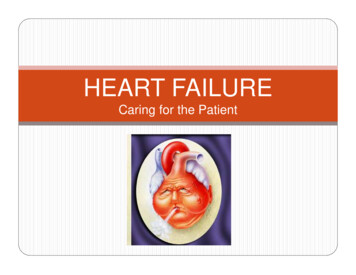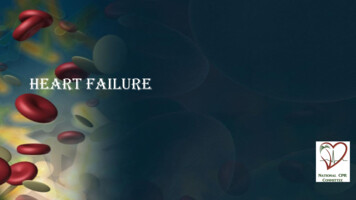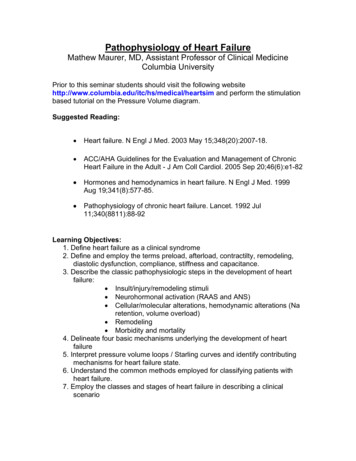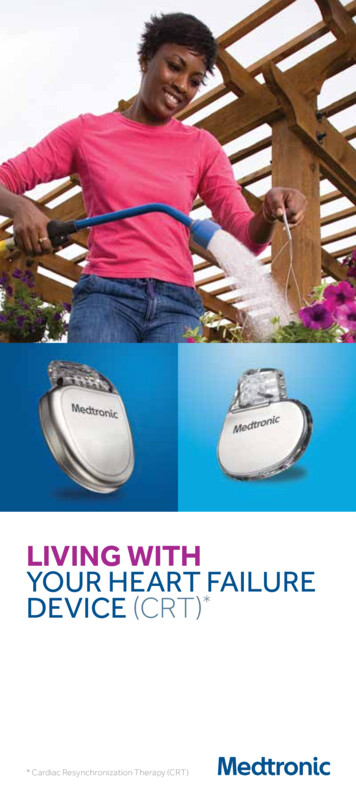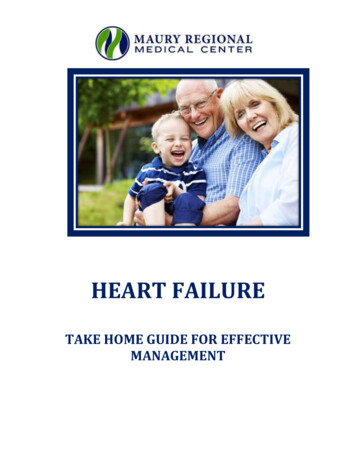
Transcription
HEART FAILURETAKE HOME GUIDE FOR EFFECTIVEMANAGEMENT
DisclaimerThe content contained in this packet is not intendedto be a substitute for professional medical advice,diagnosis, or treatment. Always seek the advice ofyour physician or other qualified health provider withany questions you may have regarding a medicalcondition.We do not offer you any warranty or guaranteerelated to the information contained in this packet;we specifically disclaim any warranties, expressed orimplied. It is the responsibility of the recipient toevaluate the information we provide and determineits relevancy and usefulness to them.Heart Failure Certification TeamReviewed April 20172
3
4
EVERY DAY:EVERYDAY Weigh yourself in the morning before breakfast, write it down and compareto yesterday’s weight. Take your medicine as prescribed. Check for swelling in your feet, ankles, legs and stomach. Eat low salt food. Balance activity and rest periods.Which Heart Failure Zone are you today? GREEN, YELLOW orRED?ALL CLEAR – This zone is your goalGREENZONEYour symptoms are under control. You have: No shortness of breath. No weight gain more than 2 pounds(it may change 1 or 2 pounds some days). No swelling of your feet, ankles, legs or stomach. No chest pain.CAUTION – This zone is a warningYELLOWZONEREDZONECall your doctor’s office if: You have a weight gain of 2-3 pounds in 1 day or a weight gain of 57pounds or more in 1 week. More shortness of breath. More swelling of your feet, ankles, legs, or stomach. Feeling more tired. No energy. Dry hacky cough. Dizziness. Feeling uneasy, you know something is not right. It is harder for you to breathe when lying down. You are needing to sleepsitting up in a chair.EMERGENCYGo to the emergency room or call 911 if you have any of the following: Struggling to breathe. Unrelieved shortness of breath while sitting still. Have chest pain. Have confusion or can’t think clearly.POST in Common area!5
HEART FAILURE(also called congestive heart failure or CHF) Heart Failure sounds really frightening if you don’tunderstand it. It doesn’t mean that your heart has stoppedworking. With heart failure, the heart continues to work butnot as effectively as it once did. It simply means that yourheart isn’t pumping blood as well as it should. Approximately 5 million Americans suffer from the effects ofHeart Failure each year. There are approximately 400,000new cases of Heart Failure diagnosed each year. By using this guide about Heart Failure, you can gain abetter understanding of heart failure and its treatment. Youwill also learn that you can live with heart failure.CONSEQUENCES OF NOT FOLLOWING YOUR TREATMENTPLAN FOR HEART FAILURE:Not following your medical treatment plan could result in: Worsening of symptoms. Irreversible damage to your heart. Damage to other organs due to lack of adequate bloodflow (kidneys, liver, brain, etc.)6
Your Treatment PlanActions Daily weightUnexplained weight gain is anearly warning sign ofworsening heart failure.Check offRead moreinformationon pages Weigh daily Use the same scale Keep a record13 Restrict Fluids cups orToo much fluid causes the ounces dailyheart to work hard to pump the intake of fluids.excess fluid volume Diet RecommendedReduce the amount of salt you diet:eat. 1500 mg of salt @ ½ tsp of salt perday. Low cholesterol Low fat ExerciseRemain ActiveCardiac rehabilitation Recommendedactivity& Frequency CardiacRehabilitation referral Smoking Cessation14-1516-2223-2627 Stop Smoking Alcohol Restrict or cut outalcohol.7
What medicines will I need to take?Many different medicines are used to treat heart failure. You mayneed to take one or more medications, depending on yoursymptoms. It may take a while to find the best medicine for youand the correct amount of it.Type of MedicineWhat the medicine does? ACE inhibitor (angiotensin convertingenzyme inhibitor)My medicineDose Causes blood vessels to relax, whichhelps reduce strain on the heart. Reduces the symptoms of heart failure.When to take Anticoagulants (also called blood thinners)My MedicineDoseWhen to take Helps prevent blood clots from formingin blood vessels (a heart attack may becaused by a blood clot) May help prevent blood clots fromgetting bigger. ARB (angiotensin II receptor blocker)My medicineDose Causes blood vessels to relax, whichhelps reduce strain on the heart.When to take Beta-blockerMy MedicineDoseWhen to take Helps keep the heart from beating tooquickly Helps keep the heartbeat regular Some help to slow down the rate atwhich heart failure gets worse.8
Type of MedicineWhat the medicine does? Calcium Channel Blocker (also calledcalcium antagonists or calcium blockers)My medicineDose Blocks calcium from moving into heartand blood vessel cells May relax blood vessels to help theheart pump less forcefullyWhen to take Digitalis Preparations (also called digoxinand digitoxin)My MedicineDose Helps relieve heart failure symptoms Slows certain types of irregularheartbeats (arrhythmias).When to take Diuretic (also called water pill)My MedicationDose Helps body to get rid of extra fluids toreduce swelling Helps lessen how hard the heart has towork Helps make breathing easier.When to take StatinMy medicationDose Reduces the level of “bad” fats (LDLcholesterol) in the blood that can blockblood vessels.When to take Vasodilators (nitrates/nitroglycerine)My MedicationDose Relaxes blood vessels and increasesblood supply to the heart, easesworkload of heart.When to take Oxygen TherapyMy amount Relaxes blood vessels and increasesoxygen to organs.Type9
Your Treatment PlanThere is a lot that can be done to improve the heart’s pumping and to treatthe symptoms, but heart failure can’t be completely cured. An importantpart of treatment is taking care of any other problems, such as high bloodpressure. Treatment also includes lifestyle changes and medicine. Hereare some important things you can change: Fluid Restriction – Your doctor will tell you the amount of fluid youare allowed each day. Diet - you will need to reduce the amount of salt you eat. Otherchanges in diet may also be recommended, such as lowcholesterol, low fat, or calorie controlled. Avoid excessive fluidintake. Some Heart Failure patients will also need a fluidrestriction. Smoking Cessation - if you smoke you will be advised to stopsmoking. Alcohol - you will be advised to restrict or cut out alcohol. Exercise - most people with heart failure can still exercise. Yourdoctor will help you decide how much and what kind of exerciseyou can do. Your doctor will decide what your activity level shouldbe. Daily weights. Family Support - involve your family as much as possible becausethey can help you adjust to the changes you must make. Other Resources of Support - your doctor can give you informationabout support groups. It sometimes helps to talk with other peoplewho have similar problems.10
What Causes Heart Failure? History of Coronary Artery Disease (narrowing of the bloodvessels of the heart) Heart attack High blood pressure (also known as Hypertension) Problems with heart valves Toxic substances (including long-term drug and alcohol use,cocaine, methamphetamines, etc.) Congenital heart disease Abnormal heart rhythms Cardiomyopathy (problems with the heart muscle itself) Chronic Renal (kidney) Disease Thyroid Disease Sometimes the exact cause cannot be found11
Signs of HF Sudden weight gain 2-3 pounds overnight, or 5-7 pounds in a week Loss of appetite or bloated feeling, nausea Shortness of breath (Shortness of breath onexertion is often the earliest symptom of HF) Trouble sleeping or shortness of breath afterlying down Dry cough Swelling of legs, ankles, or abdomen Fatigue, decreased exercise tolerance Loss of energy Unexplained confusion Rapid, irregular heart beats12
Weight Tracking ChartUnexplained weight gain is a warning sign that yourtreatment for Heart Failure may not be working as well asit has been. Daily weight tracking will help you notice aweight gain that may help prevent trips to the EmergencyRoom or stays in the hospital.Here are some guidelines to assure your weightsare accurate and comparable: Weigh DAILY Use the SAME scale Weigh first thing in the morningBEFORE breakfastAFTER urinatingSAME amount of clothing Keep a record of the daily weights13
Fluid RestrictionFluid restriction is an important part in the management ofHeart Failure. When too much fluid is taken in, the hearthas to work very hard to pump the excess fluid volume.This can worsen your Heart Failure and cause shortnessof breath, weight gain, swelling of the feet or legs andcause a bloated feeling.Your doctor has recommended that your daily intake offluids be limited to cups or ounces per day.To help you measure: ¼ cup½ cup1 cup2 cups4 cups6 cups8 cups 2 ounces 4 ounces 8 ounces 16 ounces 32 ounces 48 ounces 64 ounces 1 pint 1 quart 1 ½ quarts 2 quartsFor a guide, use a container large enough to holdcups of liquid. A standard household measuring cup isneeded for exact measuring.14
Each time fluid is consumed, measure out of the watercontainer the same amount of fluid in the item you aretaking in. For example, if you are going to drink ½ cup ofjuice, measure ½ cup of water out of the container, thendiscard the water.When the container is empty, you will have used up yourdaily fluid allowance.Count any beverage you consume as fluid:waterjuicecoffeesoft drinksteamilksoupCount fluid in all foods that become liquid at roomtemperature:ice cubessherbetPopsiclescustardIce creamfrozen yogurtpuddingice milkjellofruit iceIf dry mouth is a problem, suck on sugar-free hard candy,a lemon wedge, a popsicle, frozen orange sections, orfrozen grapes, or chew sugarless gum to moisten yourmouth. Brushing your teeth frequently will also help.Do not exceed your daily fluid allowance.15
Sodium is found in most foods. It may be natural or added during processing orcooking. To know if prepared foods have sodium added, read their food label. Look forwords such as salt and sodium. The following will help you identify foods that are highin sodium. It also provides easy guidelines to help you limit your sodium intake.Meats, Poultry, Fish, Eggs & Meat SubstitutesLimit to 6 ouncesCHOOSE Meat, fish, poultry, shellfish fresh or frozen, cooked without salt Low sodium tuna or regular tuna that has been rinsed in water anddrained Peanut butter, unsalted Tofu Eggs Low cholesterol egg substitutes Healthy Choices or Right & Light entrees (Frozen entrees with a starchand vegetable should not exceed 600 mg sodium.)Limit to 1 serving a day: Ricotta cheese, part skim Low sodium processed cheese (e.g., Alpine Lace sliced cheeses) Cottage cheese (1/2 cup) Swiss or Mozzarella cheese (1 oz)DO NOT CHOOSE Cured or processed meats: corned beef, Canadian bacon, bologna, curedham, luncheon meats, sausage, dried chipped beef, hot dogs (regular and“1/3 less sodium) Canned chicken, salmon, shrimp, sardines or meat Peanut butter, salted Textured vegetable protein (TVP) products Frozen dinner entrees (except those listed under CHOOSE) Canned entrees, such as stews, chop suey, spaghetti Processed cheeses (American, cheese spread, cheese food) All other natural cheesesBrought to you by Morrison’s16
VEGETABLESCHOOSE Canned vegetables, with no added salt Raw vegetables Fresh or frozen vegetables, cooked without salt Canned vegetables, rinse and drain before preparation (limit to 1 cup per day) Instant mashed potatoes, omit salt when preparing Low sodium tomato or vegetable juice Tomato sauce, no salt added Tomato paste, no salt addedDO NOT CHOOSE Baked Beans Sauerkraut Pickles and pickled vegetables Frozen seasoned vegetable dishes Coleslaw and potato salad, unless homemade, without salt Tomato or vegetable juice Tomato sauce Tomato pureeSOUPSCHOOSE Low sodium canned soups Homemade soups and broth, with no added salt Low sodium soup basesDO NOT CHOOSE All soups and broth, unless low sodium “1/3 less salt” soups Dehydrated soup mixesMilk & YogurtLimit to 2 cups per dayCHOOSE Milk: whole, reduced-fat, low-fat, fat-free, chocolate, powered, evaporated Yogurt: plain or fruitedDO NOT CHOOSE ButtermilkBrought to you by Morrison’s17
BREADS, CEREALS, GRAINS, CRACKERSLimit to 6 servings per day.CHOOSE Yeast breads and rolls Bagel (1/2) English Muffin (1/2) Pita (1) Muffin (1 small) Bread dressing, homemade with no added salt (1/3 cup) Pancakes (1-4” diameter) Doughnuts, yeast (1) Crackers, unsalted tops (5) Dry cereal (3/4 cup), except those listed under NO LIMITNO LIMIT Hot cereal, cooked without salt Dry cerealso Puffed rice or puffed wheato Shredded wheato Wheat germo Low sodium cornflakeso Low sodium crispy rice Crackerso Low sodium crackerso Unsalted matzoho Melba toast Tortillas Pasta, noodles, or rice, cooked with no added saltDO NOT CHOOSE Refrigerated dough Danish pastries Toaster pastries Bagels with salt toppings Biscuit mix Cornbread mix Commercially seasoned stuffing Frozen waffles Crackers with salt tops18
Brought to you by Morrison’sBEVERAGESCHOOSE Coffee and tea Cereal beverages Carbonated beverages Soft drinks and punch Mineral waterDO NOT CHOOSE Coca beverage mixes Sport beverages (such as Gatorade )FRUITS & JUICES ALL ARE ACCEPTABLEEATING OUTToday, many restaurants provide nutrition information about their menu items. Sincemost fast foods and ethnic foods (Chinese, Mexican, Italian) are high in sodium, ask tosee this information before making a selection. Upon request, some fast foodrestaurants will accommodate your needs, such as leaving the salt off your French fries,or the ketchup off your burger. Another choice is to order a salad and add a squeeze oflemon instead of dressing, which is generally high in sodium. At restaurants thatprepare foods “made to order”, ask that your meal be prepared without salt or MSG.FOOD LABELSLabels can be useful. The following are sodium-labeling definitions: SODIUM FREE –Less than 5 milligrams of sodium per serving VERY LOW SODIUM Less than 35 milligrams per serving LOW SODIUM Less than 140 milligrams per sodium REDUCED OR LESS SODIUM –The product has at least 25 percent less sodium than the original product LIGHT –A product has at least 50 percent less sodium OR 1/3 fewer calories OR 50percent less fat than the original product NO SALT ADDED OR NO SALT – No salt has been added in the preparationof the product *CAUTION: Many products with less sodium, less salt, lite, orlight on the label still may have too much sodium. Sea Salt is the same as table salt in its sodium content but just withbigger crystals.19
Brought to you by Morrison’sFATSCHOOSE Oil or shortening Cream cheese Cream, dairy and non-dairy Sour Cream Low sodium salad dressing (commercial or homemade) Imitation whipped toppingLimit to 4 servings per day: Butter, margarine (1 tsp) Mayonnaise (1 Tbsp)Limit to 1 serving per day: Salad dressing: regular or fat-free (1 Tbsp)DO NOT CHOOSE Tarter sauce Bacon, bacon fat “1/3 less sodium” Gravy: canned, jarred or packet Salt Pork Dips Salad dressing: regular or fat-free (unless limited to 1 Tbsp per day)SNACKS & SWEETSCHOOSE Popcorn: homemade, unsalted; microwave, unsalted Pretzels, unsalted Nuts, unsalted Sugar, honey Jam or jelly Syrups: maple, corn, chocolate, etc. Cranberry sauce Candy Gelatin Ice cream, sherbet, or frozen yogurt PopsiclesLimit to 1 serving per day: Pie (1/8 – 9” diameter) Pudding (1/2 cup) Cookies (2) Custard (1/2 cup) Cake (1/16 – 9” diameter)DO NOT CHOOSE Popcorn: commercial seasoned or microwave with salt Snack chips, pretzels or crackers with salt Olives Nuts with salt Cheesecake Instant pudding mixes20
CONDIMENTSCHOOSE Herbs and spices without salt, (e.g., onion and garlic), horseradishpowder, vinegar, Mrs. Dash , Tabasco sauceLimit to 1 serving per day: Mustard (1 tsp) Ketchup (1 tsp) Worcestershire sauce (1 tsp)DO NOT CHOOSE Salt, herb and spice blends containing salt Monosodium glutamate (MSG)Note: MSG has no taste so it is not detected in foods! Soy sauce Teriyaki sauce Poultry seasoning Barbecue sauce Chili sauce Steak sauce Relish Poppa Dash Brought to you By Morrison’s21
Use the food label to help you choose appropriate foodsfor your diet.Check the servingto see how muchyou will be able toeat for the sodiumamount.Single serve itemswith 140mg or lessare good low sodiumchoices.22
The Right Balance Between Activity& RestYou can help strengthen your heart by doing some type ofphysical activity every single day. You may wonder howactive you should be. You will have to learn how tobalance your need for physical activity with your need forextra rest. How active should you be? Talk to your doctor before starting an exercise program.Your doctor will work closely with you to figure out how muchactivity you can comfortably handle. Whatever you do, goslowly and give yourself plenty of time to adjust to theincreased activity. You must listen to your body. If you feelpoorly after physical activity, take it easy until you feel better. Remember, sexual activity is physical activity, too. Yourdoctor can also advise you when to resume sexual activity.As a general rule, it’s good for people with heart failure to stayactive. This helps keep you in good shape so you can feel betterand do more. Talk with your doctor or nurse about starting aphysical activity program. You may need a supervised exercisestress test before you start.23
Activities such as walking, swimming or biking may berecommended. Avoid activities where you have to hold yourbreath, bear down or use sudden bursts of energy. Don’t liftheavy weights or move heavy furniture. These activities maycause difficulty in breathing. Stop and rest if any activity causeschest pain, shortness of breath, dizziness or lightheadedness.Try not to be active right after meals, when it’s hot or humid, whenit’s cold or when you don’t feel good.How much rest do you need? Giving yourself enough time to rest is vital to health andwell-being. Resting for 30 to 60 minutes after meals andbetween daily activities eases the stress on your heart. Inaddition, plan time each day for relaxing activities, such asreading, sitting outside in the fresh air or watching TV. Andremember to put your feet up to help reduce swelling of yourlegs and ankles.24
Tips on Balancing Activity and Rest Take it slow and easy Choose lighter activities at first, such as walking orshopping. Take rest breaks often. As you begin tofeel stronger, gradually increase your activities andshorten rest periods. Recognize that it can take timeto build up your endurance. Be patient with yourself. Pace yourself Always try to do activities when you are well rested. Allowenough time for each activity. Space activities out during theday and stop before you get too tired. Modify tasks so that youcan sit while doing them. Stand up or sit down slowly to avoidbecoming lightheaded. Lighten up Lifting heavy objects, straining to reach things, and using toomuch “elbow grease” all make your heart work harder. Insteadof lifting heavy grocery bags or piles of laundry, use a wheeledcart or divide them into smaller bundles. Keep items you useall the time within easy reach. Avoid strenuous arm motionswhile doing household chores, such as vacuuming, moppingfloors, washing windows or working in the yard.25
Avoid temperature extremes Being too hot or too cold places extra stress on the heart.Adjust your routine based on the weather and dressappropriately. Save activities for the cooler, less humid hoursof the dayGREAT NEWS FOR HEART FAILURE PATIENTS:CMS (Centers for Medicare & Medicaid Services) has confirmed thatpatients with chronic, stable, heart failure can receive cardiac rehabilitationservices. This means patients who meet the eligibility criteria may now bereferred to cardiac rehabilitation.Eligibility criteria are: Patients with left ventricular ejection fraction of 35% or less New York Heart Association (NYHA) class II to IV symptoms despitebeing on optimal heart failure therapy for at least six weeks. Stable patients are defined as patients who have not had recent ( 6weeks) or planned ( 6 months) major cardiovascular hospitalizationsor procedures.Ask your doctor if these criteria apply to you!26
27
Be Alert to Your SymptomsYour symptoms provide vital clues to how well your heart failure treatmentis working. If you notice any changes in your symptoms, call your doctor. Increased Shortness of BreathEspecially when you are lying down or when you exert yourself Extreme fatigueWhile doing activities you used to be able to do more easily Sudden weight gain2-3 pounds overnight or 5-7 pounds in a week Swelling of legs, ankles, or feet Frequent coughingEspecially when you are lying down or coughing up blood Rapid, irregular heartbeatsOr a feeling that your heart is “racing” Dizziness or fainting Chest pain or pressure –take your angina medicine as directed – stopwhat you are doing Nausea, loss of appetite, bloating, or tenderness in the area of thestomach Decreased urination You have blurred vision or see yellowish-green halos around objectsor lightsGo to the EMERGENCY ROOM IF:I You have unrelieved tightness or pain in your chest You are extremely short of breath You are coughing up pink frothy mucus You are traveling and develop symptoms of worsening heartfailureIf you have angina or chest pain, stop what you are doingand rest immediately.Take your angina medicine asdirected. If your pain does not go away, call 911. This is amedical emergency.28
TYPES of HEART FAILURESymptoms can help doctors find out which side of your heart isnot working properly.If the left side of your heart is not working properly (left-sidedheart failure), blood and fluid back up into your lungs. You will feelshort of breath, be very tired, and have a cough (especially atnight). In some cases, patients may begin to cough up pinkish,blood-tinged sputum.If the right side of your heart is not working properly (right-sidedheart failure), the slowed blood flow causes a buildup of fluid inyour veins. Your feet, legs, and ankles will begin to swell. Thisswelling is called edema. Sometimes edema spreads to the lungs,liver, and stomach. Because of the fluid buildup, you may need togo to the bathroom more often, especially at night. Fluid buildup isalso hard on your kidneys. It affects their ability to dispose of salt(sodium) and water, which can lead to kidney failure. Once CHFis treated, the kidneys' function usually returns to normal.Approximately 5 million Americans suffer from the effects of HeartFailure each year. There are approximately 400,000 new casesof Heart Failure diagnosed each year.29
By using this guide about Congestive Heart Failure, you can gaina better understanding of heart failure and its treatment. You willalso learn that you can live with heart failure.Meaning of Ejection Fraction (EF)The Ejection Fraction (EF) is an important measurement of howmuch blood the left ventricle pumps out with each contraction(beat). It is used to determine (diagnose) heart failure and trackthe progression of heart failure.Normal EF:A normal ejection fraction may be between 55 and 70. (You canhave a normal ejection fraction reading and still have heart failure).YOUR EF:CLASSIFICATIONS OF HEART FAILURE:Class How a patient with cardiac disease feels during physical activity.Patients with cardiac disease but resulting in no limitation of physicalIIIIIIIVactivity. Ordinary physical activity does not cause undue fatigue,palpitation, dyspnea or angina pain.Patients with cardiac disease resulting in slight limitation of physicalactivity. They are comfortable at rest. Ordinary physical activityresults in fatigue, palpitation, dyspnea or angina pain.Patients with cardiac disease resulting in marked limitation ofphysical activity. They are comfortable at rest. Less than ordinaryactivity causes fatigue, palpitation, dyspnea or angina pain.Patients with cardiac disease resulting in inability to carry on anyphysical activity without discomfort. Symptoms of heart failure orthe angina syndrome may be present even at rest. If any physicalactivity is undertaken, discomfort increases.30
PALLIATIVE CARE:Palliative care is specialized medical care for people with seriouslife-threatening illnesses. It focuses on providing patients withrelief from the symptoms, pain and stress of a serious illnesswhatever the diagnosis. The goal is to improve quality of life forboth the patient and the family.Palliative care is provided by a team of doctors, nurses, and otherspecialists who work together with a patient’s other doctors toprovide an extra layer of support. It is appropriate at any age andat any stage in a serious illness and can be provided along withcurative treatment.31
HEART FAILURE (also called congestive heart failure or CHF) . Daily weight Unexplained weight gain is an . Weight Tracking Chart Unexplained weight gain is a warning sign that your treatment for Heart Failure may not be working as well as it has been. Daily weight tracking will help you notice a
